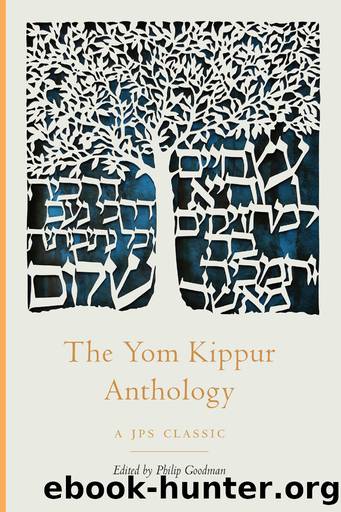The Yom Kippur Anthology by Goodman Philip;Jewish Publication Society;

Author:Goodman, Philip;Jewish Publication Society; [Goodman, Philip]
Language: eng
Format: epub
ISBN: 978-0-8276-1348-5
Publisher: University of Nebraska Press
Published: 2018-04-15T00:00:00+00:00
THE TWO-DAY YOM KIPPUR IN JAPAN
DAVID KRANZLER
During World War II a situation developed wherein a group of refugees in Kobe, Japan, observed the Sabbath for two days (i.e., on Saturday and Sunday in Japan) and fasted a full forty-eight hours on Yom Kippur. The unusual circumstances occurred when two thousand Jews from Nazi-occupied Poland found a temporary haven in Kobe, after having traversed Siberia. Among these Polish refugees was a group of about five hundred rabbinic students and teachers, more than half from the famous talmudic college of Mir, Poland. Here questions were raised about the proper day for observing the Sabbath, Yom Kippur, and other Jewish holy days. These doubts were due to the problem of the location of the âJewish Date Line.â
What is presently the universally accepted position of the International Date Line is the arbitrary, almost uninterrupted hypothetical line measuring 180 degrees longitude from Greenwich, England, passing along most of its length through the Pacific. This line was found to be the most convenient place for mariners to change dates, since the farther eastward one travels without adjusting his watch, the shorter the length of the dayâ one hour per 15 degreesâas measured from noon to noon. Traveling westward one will find a corresponding increase in the length of the dayâtraveling twenty-four hours for 360 degrees. Thus, for example, a traveler going west from San Francisco to China loses one day when crossing this date line, while gaining a day going in the opposite direction.
As early as the medieval period differences arose as to the location of the âJewish Date Line.â This issue achieved prominence during the early months of 1941 as the rabbinical students and scholars poured into Kobe, and it became crucial with the approach of Yom Kippur that year. For the purpose of resolving the doubts raised by the rabbinic students concerning this holiest of Jewish days, an assembly of rabbis was convened in Jerusalem in September 1941 under the leadership of Chief Rabbi Isaac Halevy Herzog. After much learned discussion, the assembly concluded that neither the Sabbath nor Yom Kippur should be changed from the calendar observed in Kobe, although the reasoning for this decision differed among the authorities. A telegram was sent by Rabbi Herzog to the refugees in Kobe on behalf of the rabbinical assembly, advising them not to make any change from Wednesday for the local observance of Yom Kippur.
Indeed, along similar lines, the old-time Jewish community of Kobe, comprised of about fifty families of Sephardic as well as Russian Ashkenazic origin, relied upon the decision of Aaron Moshe Kisseloff of Harbin, Manchuria, chief rabbi of the Far Eastern Jewish communities, who also advised that they refrain from making any change in the locally established days.
One lone voice of dissent reached Kobe, stating categorically that the refugees were âto eat on Wednesdayââthe local Yom Kippurâand âfast on Thursday.â So wrote Rabbi Avraham Yeshayahu Karelitz (better known as the Hazon Ish), considered one of the greatest Torah authorities of the past generation, who disagreed with the conclusions of the rabbinical assembly.
Download
This site does not store any files on its server. We only index and link to content provided by other sites. Please contact the content providers to delete copyright contents if any and email us, we'll remove relevant links or contents immediately.
| Haggadah | Hasidism |
| History | Holidays |
| Jewish Life | Kabbalah & Mysticism |
| Law | Movements |
| Prayerbooks | Sacred Writings |
| Sermons | Theology |
| Women & Judaism |
The Secret Power of Speaking God's Word by Joyce Meyer(2744)
Man's Search for Meaning by Viktor E. Frankl(2551)
Mckeown, Greg - Essentialism: The Disciplined Pursuit of Less by Mckeown Greg(2328)
MOSES THE EGYPTIAN by Jan Assmann(2273)
Devil, The by Almond Philip C(2198)
Unbound by Arlene Stein(2176)
The Complete Dead Sea Scrolls in English (7th Edition) (Penguin Classics) by Geza Vermes(2135)
I Capture the Castle by Dodie Smith(1902)
Schindler's Ark by Thomas Keneally(1758)
The Invisible Wall by Harry Bernstein(1702)
The Gnostic Gospel of St. Thomas by Tau Malachi(1674)
The Bible Doesn't Say That by Dr. Joel M. Hoffman(1606)
The Secret Doctrine of the Kabbalah by Leonora Leet(1526)
Political Theology by Carl Schmitt(1500)
The Jewish State by Theodor Herzl(1466)
A History of the Jews by Max I. Dimont(1437)
The Dead Sea Scrolls Bible by Martin G. Abegg(1422)
The Book of Separation by Tova Mirvis(1418)
Oy!: The Ultimate Book of Jewish Jokes by David Minkoff(1291)
